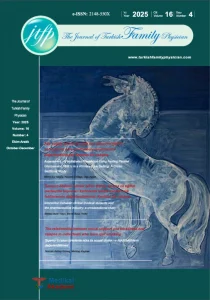A qualitative research about autism friendly house environment
Introduction and Objectives: A qualitative research about problems children with autism have in their home enviroment, changes to combat these problems, and their outcomes.
Materials and Method: The research was conducted at a rehabilitation center in Kartal District of İstanbul. 8 parents accepted to attend. Data was collected through indepth interviews with semistructured questionnaire to find out demographic characteristics of the families of children having autism, difficulties that children experience in home environment, changes as to how parents overcome these difficulties, and their outcomes. Interviews were conducted in an environment provided by the facility. Each interview took 25-30 minutes and was recorded with a mobile device. All recordings were listened by the researchers twice and converted into a text, then each text was coded by two separate researchers independently. After the coding, thematic analysis was made.
Findings: Participants (n=8) consist of parents of children with autism between ages 4-14. Mean age of diagnosis is approximately 2 years 3 months. Most of the children have mild autism (n=7). Parents haven’t made any changes regarding home environment and structure. All participants live with their small families in apartment buildings and they have gardens available. Although crises (temper tantrums) are not frequent, child safety was tried to be achieved. Parents have used educational toys and materials to create an educational environment at home. Parents also took safety measures similar to children without autism. Primary precautions are locking dangerous areas like kitchen, securing the windows and getting rid of sharp edged furniture. Parents think children are safe at home. Repetitive accidents have been reported.
Conclusion: Safety and education are determinants of leading changes made in home environments of children with autism. The main target is not to change physical factors which bother the children such as lighting and noise, instead let the child face them and adapt to these factors as part of sensory integration therapy.
References
- Özsungur BAD, Çengel KE, Zeki A, Sınır H. Çok erken başlangıçlı şizofrenide klinik görünüm ve tanı güçlükleri: Olgu sunumları. Çocuk ve Gençlik Ruh Sağlığı Dergisi 2012;19(2):87-95.
- Kılıç EÖ. Dünyada Her 68 Çocuktan Birisi Otizmli Doğuyor. http://bilimgenc.tubitak.gov.tr/makale/dunyada-her-68-cocuktan-birisi-otizmli-doguyor adresinden 05/09/2017 tarihinde erişilmiştir.
- Yücesoy ÖŞ. Ergenekon Y, Çolak A, Kaya Ö. Otizm Spektrum Bozukluğu. (ed) Cavkaytar A. 2.baskı. Ankara, Engelli ve Yaşlı Hizmetleri Genel Müdürlüğü. 2016;37-44.
- Braddock G RJ. Making Homes that Work, A Resource Guide for Families Living with Autism Spectrum Disorder+Co-occurring Behaviors. Oregon, Creative Housing Solutions and Rowell Brokaw Architects, PC. 2011;7-8.
- Kinnaer MBS, Heylighen A. How do People with Autism (Like to) Live?. In “Inclusive Designing: Joining Usability, Accessibility, and Inclusion”. (eds) Heylighen ADH, Langdon PM, Lazar J, Lazar J. University of Cambridge. London, Springer-Verlag Ltd. 2014;175-85.
- Doenyas C. The Social living complex: A New, all day, yearlong intervention model for individuals with Autism Spectrum Disorder and their parents. Journal of Autism And Developmental Disorders 2016;46(9):3037-53.
- Pan CY FG. Physical activity patterns in youth with autism spectrum disorders. Journal of Autism and Developmental Disorders 2006;36(5):597-606.
- Tohum Otizm Vakfı: Otizm Spektrum Bozukluğu (OSB) şimdi ne olacak? İstanbul, T.C. Milli Eğitim Bakanlığı Özel Eğitim ve Rehberlik Danışma Hizmetleri Genel Müdürlüğü. 2014;14-9.
- Long EA. Classroom lighting design for students with autism spectrum disorders. Report for the Master of Science degree. Kansas State University; 2010. https://core.ac.uk/download/pdf/5170701.pdf adresinden 05/09/2017 tarihinde erişilmiştir.
- Kanakri SM, Varni JW, Tassinary LG. Noise and autism spectrum disorder in children: An exploratory survey. Research in Developmental Disabilities 2017;63:85-94.
- Richdalea AL, Schreck KA. Examining sleep hygiene factors and sleep in young children withand without autism spectrum disorder. Research in Autism Spectrum Disorders 2019;57:154-62.
- Berger DS. “Music Therapy, Sensory Integration and the Autistic Child.” London, Jessica Kingsley Publishers Ltd, 2002.
- American Psychiatric Association. Diagnostic and Statistical Manual of Mental Disorders. 5th ed. Washington DC, 2013. https://doi.org/10.1176/appi.books.9780890425596.
- Ashwin CE, Howells J, Rhydderch D, Walker I, Baron-Cohen S. Enhanced olfactory sensitivity in autism spectrum conditions. Molecular Autism 2014;5(1):31-50.
- Grandgeorge M, Masataka N. Atypical Color Preference in Children with Autism Spectrum Disorder. Frontiers in Psychology 2016;7:1976.
- Yanardağ M, Yılmaz İ. Otistik bozukluk gösteren çocuklarda bir müdahale yaklaşımı: Su içi etkinlikler. International Journal of Early Childhood Special Education 2012;4(1):32-45.
- Barakat H, Bakr AF, El-Sayad Z. Nature as a healer for autistic children. Environmental Science and Sustainable Development 2019;42-62.



